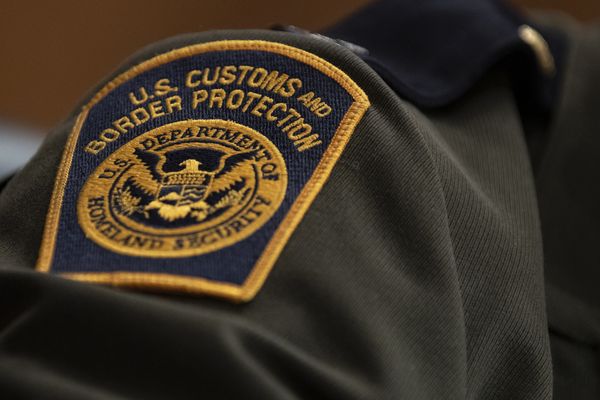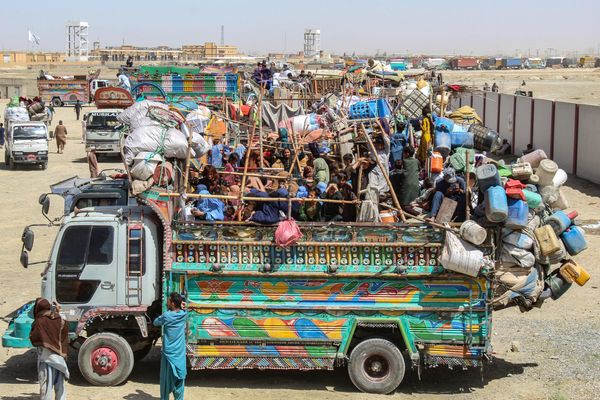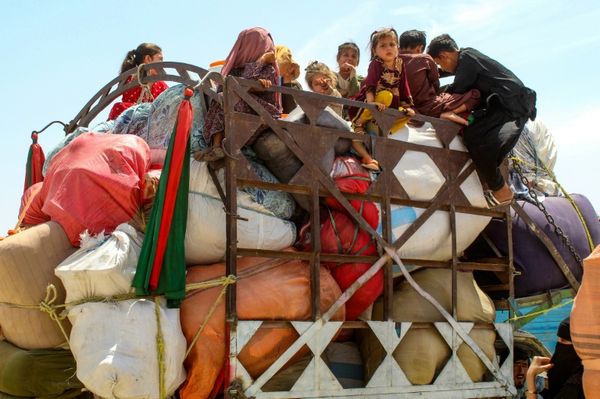“They were left up there for political reasons.”
Elon Musk
Two of the most powerful people in the world continue to push the "stranded astronaut" narrative.
In a recent interview with Fox News' Sean Hannity, SpaceX CEO Elon Musk and President Trump were asked about the administration's plans for space, their commitment to landing astronauts on Mars, as well as their commitment to "rescue," as Hannity put it, the two "abandoned" astronauts. Trump and Musk agreed with that framing, doubling down on a false narrative about NASA astronauts Suni Williams and Butch Wilmore's mission aboard the International Space Station.
"At the President's request," Musk tells Hannity, "we are accelerating the return of the astronauts, which was postponed kind of to a ridiculous degree," he said. "They got left in space," Trump added. But Williams and Wilmore did not get "left in space," as Trump and Musk have repeatedly maintained, and neither offered any evidence to support the claim of political interference. And the "stranded" part doesn't hold up to scrutiny, as NASA has long had a plan to bring the duo home — and it already involves SpaceX.
On June 4 of last year, Williams and Wilmore launched to the International Space Station (ISS) on the first crewed flight test (CFT) of Boeing's Starliner spacecraft. Their mission was scheduled to last about 10 days, but complications with Starliner extended their orbital stay — a contingency well prepared for by NASA and the astronauts.
As Starliner approached the ISS, Williams and Wilmore noticed problems with some of its thrusters. The astronauts were able to successfully dock with the space station, but NASA and Boeing decided to study the issue in detail.
The investigation into Starliner's thruster malfunctions spanned several weeks, with NASA continuing to delay Williams and Wilmore's return. In that time, NASA repeatedly voiced assurances that, in the event of an emergency, NASA and Boeing were confident in Starliner's ability to serve as a lifeboat to bring the astronauts home.
“I want to make it very clear that Butch and Suni are not stranded in space,” NASA’s Commercial Crew Program Manager Steve Stich said during a June 28 press conference.
Finally, on Aug. 24, after exhaustive ground tests to recreate and study the thruster problem, NASA announced that it had decided to fly Starliner back to Earth uncrewed. Williams and Wilmore would be absorbed into ISS Expedition 72 and added to the manifest of SpaceX's Crew-9 mission, which was scheduled to launch a month later. Crew-9 was adjusted to lift off with only two of its original four astronauts aboard, in order to save seats for the Starliner duo during the return trip at the end of their rotation.
“NASA has decided that Butch and Suni will return with Crew-9 next February, and that Starliner will return uncrewed,” NASA Administrator Bill Nelson said on Aug. 24. He added that Boeing worked closely with the space agency to review the available data, and that a conclusion was reached following a unanimous poll of NASA officials and technicians familiar with the mission and the spacecraft.
As is typical for NASA crew rotations on the space station, Crew-9's arrival kicked off final preparations for Crew-8's departure, which took place Oct. 23. It's NASA policy for crews to overlap to give new station residents time to adapt and get oriented by the departing crews.
Crew-9's mission aboard the ISS won't wrap up until Crew-10 arrives, which was originally scheduled for February. Crew-10 was slated to fly a brand-new Dragon spacecraft, currently being built by SpaceX, but delays in the vehicle's assembly in December led NASA to push Crew-10 to no earlier than "late March."
Then came the presidential inauguration.
A week after taking the oath of office, President Trump made a post on social media that picked up the "stranded astronaut" narrative, which some media outlets had already been promulgating.
"I have just asked Elon Musk and @SpaceX to ‘go get’ the 2 brave astronauts who have been virtually abandoned in space by the Biden Administration. They have been waiting for many months on Space Station. Elon will soon be on his way. Hopefully, all will be safe. Good luck Elon!!!"
I have just asked Elon Musk and @SpaceX to “go get” the 2 brave astronauts who have been virtually abandoned in space by the Biden Administration. They have been waiting for many months on Space Station. Elon will soon be on his way. Hopefully, all will be safe. Good luck…January 29, 2025
Coincidentally — or not, perhaps — two weeks later, NASA announced that, rather than wait for the new Dragon to be ready for Crew-10, it had instructed SpaceX to prepare a flight-proven Dragon in order to launch the mission sooner. Crew-10 is now scheduled to lift off no earlier than March 12, which would likely put the departure of Crew-9, with Williams and Wilmore on board, sometime in late March or early April.
Now, Musk and President Trump are continuing the "stranded" narrative, even though none of the astronauts aboard the ISS lack a ride home.
"They didn't have the go-ahead with Biden. He was going to leave them in space," the president said during the Fox interview, before turning to Musk to ask, "When are you going to launch?"
Musk's response: "About four weeks."
The Crew-10 timeline, however, isn't much in Musk's control. Regardless of NASA's motivation for swapping Dragons for the Crew-10 mission, its launch and Crew-9's subsequent return to Earth are part of the agency's massively complex logistical framework that manages everything on the ISS from which astronauts are on board to how much food to pack on the next cargo flight.
The point is, NASA's crew rotations aboard the space station generally exist outside the whims of political influence. The space agency and the astronauts know this, and they've pushed back against the "stranded" narrative.
"That is what your human spaceflight program is: It prepares for any and all contingencies that we can conceive of," Wilmore told Anderson Cooper in a recent interview with CNN. "We don't feel abandoned. We don't feel stuck. We don't feel stranded."
Wilmore asked Cooper to help "change the rhetoric."
NASA officials have been sending the same message for months.
“They were never stuck or stranded. They've always had a way to depart the space station. And, to me, when somebody is stranded, there's a location where they cannot leave," Stich said during a Sept. 4 press conference, just before Starliner departed the ISS.
"They've transitioned from their role as Starliner test pilots, and now they're part of the [ISS] expedition, working day in and day out,” Stitch said at the time.
And, in a recent interview with CBS's John Dickerson, Williams rebuffed the president's claim that she and Wilmore had been abandoned. "I don’t think those words are quite accurate," she told Dickerson. "We are part of something bigger than ourselves; we are part of the International Space Station. So, no, we don’t feel abandoned. We feel like we are part of the team, and that’s a huge honor.”
In his Aug. 24 remarks, when the agency announced Starliner would return without its astronauts, Administrator Nelson framed the agency's decision within the context that such endeavors entail, stressing that NASA has a heightened awareness of the consequences of its choices in the human spaceflight arena.
"We have had mistakes done in the past. We lost two space shuttles as a result of there not being a culture in which information could come forward," Nelson said.
"We have been very solicitous of all of our employees that, if you have some objection, you come forward. Spaceflight is risky, even at its safest and even at its most routine," he added. "And a test flight, by nature, is neither safe nor routine. So, the decision to keep Butch and Suni aboard the International Space Station and bring the Boeing Starliner home uncrewed is a result of a commitment to safety. Our core value is safety. It is our North Star. And I'm grateful to NASA and to Boeing for their teams, for all the incredible and detailed work to get to this decision.”
Never in any press conference or publicly available statement has NASA asserted or implied that political influence played a role in the decision for astronauts Williams and Wilmore to remain on orbit. And, in interviews when asked directly, both astronauts have expressed satisfaction with the agency's choice and the opportunity the mission has given them to live and work in space again.







